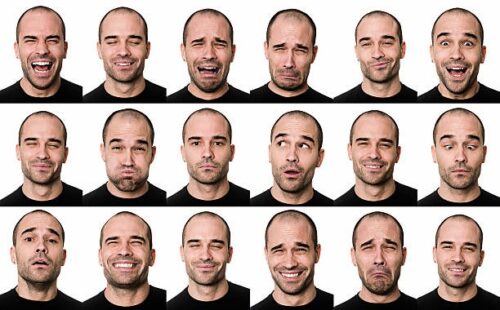Human communication relies heavily on facial expressions, particularly when conveying emotions. Recognizing and analyzing facial reactions or expressions improve one’s ability to communicate with people and facilitate better interactions. The article will examine the connection between emotions and facial features and expressions and how they relate to the personality of another human being.

The psychological investigation of the connection between personality and facial traits is known as morphopsychology. This area of psychology concentrates on how a person’s facial form and structure might provide insight into their personality, feelings, and behaviors. Although morphopsychology has existed as an area of study over the years, it has just recently been applied to psychotherapy as a means of comprehending and assisting clients.
Developed by Louis Corman, morphopsychology is an unofficial field of study in its early stages that uses the particulars and generalities of one’s facial appearance to observe human behavior, character, competence, and mindset. It is not supported by science, meaning it is not a scientific discipline. However, although it is not recognized by social psychology experts today, the field of research is comparable to the way we acquire knowledge and explore human facial structure or physiognomy.
Other researchers and scientists today are also dabbling in it. Knowledge and development in this area can help us get a better grasp of the perception of facial expressions without needing words. This can help us improve how we navigate a relationship, identify shifts in behavior, and determine the best course of action for a certain form of situation.
Before experts developed methods for measuring psychology and gathering data to support their hypotheses, the field needed to learn more about psychology. People naturally approached it from an artistic or metaphysical viewpoint because it’s not a straightforward science like physics. Though it might not hold today, the development of this idea was essential to our understanding of where we are now.
The Language Of The Face
A new perspective on human nature can be gained through the application of morphopsychology. Acquiring the ability to pay attention to one’s face is crucial. It is an area of study that considers how physiology might reveal certain information about an individual’s way of life. To be precise, certain facial expressions can also convey an individual’s mental state. Like for example, an angry and depressed person will often have a stiff expression and a downcast head. It is an area of study that establishes connections between an individual’s psychological background and facial features.
Since this field of study has drawn a lot of opinions and objections, one should see their expertise as information that is complementary to and partial to other viewpoints that provide a better picture of the individual. From an informal perspective, morphopsychology examines facial communication in search of a certain meaning. Morphopsychology’s ideology is “understanding without passing judgment.” Respecting the human being and utilizing potential while also illuminating the different components of human nature is the goal.

Face And Personality Theory
The human face may be split into three distinct sections at the morphological phase, and the proportionate amount of these regions can provide valuable insight into an individual’s personality and character. This is in line with the notion of morphopsychology. It can also provide useful hints as to whether one has intellectual, passionate, or intuitive intelligence.
Cerebral: When the most noticeable ones are the area that consists of the forehead, eyes, eyebrows, and temples, this portion provides insight into the person’s mentality and intellect. In general, a person’s capacity for analyzing and interpreting information and performing better in tasks requiring cognition and computation is correlated with the size of their top skull.
Sentimental: When the parts that are noticeable are the cheekbones, cheeks, and nose, this means that individuals are typically extremely sensitive individuals with skills in showing sympathy and taking care of others. Their emotions often get the better of them. Thus, the level of emotionality is indicated by this central region of the face.
Instinctive: These include noticeable parts such as the mouth, chin, and lower jaw. These are the kind of people whose viewpoints and behaviors are typically driven by instincts and impulses. Generally speaking, this face region’s more prominent status is linked to a more aggressive and unpredictable personality.
How Can Morphopsychology Be Used?
The foundation of morphopsychology is the notion that the human face is an access point into the psychological state. Each face feature is believed to relate to a certain personality trait, such as friendliness, compassion, or intellect. A therapist can personalize treatment sessions and interventions by using facial analysis to acquire knowledge concerning a client’s behaviors and personality traits.
The methodology is astoundingly innovative. The information that is seen on a person’s face originates from their nervous system. The muscles get signals from the neurological system of the human brain and adjust their own position accordingly.
Facial analysis or facial evaluation is the main method in morphopsychology. This entails analyzing the shape, form, and location of various face attributes, such as the mouth, nose, and eyes, and projecting the character traits they disclose. For instance, it is believed that a broad forehead indicates cognitive ability, whereas decisiveness and confidence are linked to a wide jaw.
Additionally, the face serves as the main channel for communicating feelings to other people and can convey a great deal regarding a person’s emotional state. That explains why a therapist can learn more about a client’s emotional state and assist them in better understanding and managing their feelings by examining their facial expressions.

Facial Expressions And Emotions
Understanding facial expressions is a crucial component of morphopsychology. You truly won’t understand someone if you just pay attention to what they say and ignore what their expression is trying to tell you. Words frequently don’t convey feelings that are felt, yet a person’s face does.
The relationship between facial expressions and the emotions detected from them has been unclear from the early days of facial-determining research. These classifications have consistently been used to identify the facial expression responses that are regarded as pleased, angry, afraid, dissatisfied, disappointed, or astonished. It should be noted, however, that classifications indicating emotions and facial expressions are not alike. Facial expressions are perceived as physical impulses on people’s faces from the perspective of the perceiver. The emotional readings of the expressions are predictive interpretations of the subconscious conditions of perceived emotion that people make.
While seeing facial expressions is crucial, keep in mind that merely identifying the feeling doesn’t always indicate its source. An individual may appear dissatisfied, angry, or uninterested in a variety of causes, some of which may not even be related to you.
The benefit of reading facial expressions is that you may use them to gauge whether someone else appears to be feeling and adjust your interactions appropriately. For instance, when an individual seems uninterested, it’s possible that they’re simply exhausted and that the conversation should discontinue.
Micro-Expressions
Not all expressions on the face are permanent. Micro-expressions are fleeting moments that are nearly undetectable to the untrained eye. The feelings that are conveyed by micro-expressions are equivalent to those of a more persistent facial expression despite their fleeting nature.
Even when someone is attempting to disguise their genuine emotions, they are the kind of short-lived, complex movements of the face that might expose it. Some professionals can better understand people’s emotions and assist them in identifying and expressing their sentiments by learning to recognize microexpressions. Although it can be challenging at times to recognize and understand micro-expressions, it is an ability that can be acquired. Being aware of small facial expressions may also enhance your comprehension of the emotions of other individuals in general.
How to Recognize Expressions on Your Face Based on Features
We use our faces to communicate a lot of information that is not verbal, and when you try to decipher what an expression might signify, you often concentrate on different parts of the face. You can tell whether a particular individual is cheerful or unhappy, for example, by looking at their mouth or by looking into their eyes.
Eyebrows
It is possible for eyebrows to convey diverse emotional cues; in fact, they may be just as critical for facial identification as eyes. The eyebrows can be:
- Raised and curved as if in surprise or astonishment at something
- Lowered and knitted together, frequently connoting fear, grief, or rage
- Pulled up within the inner nooks, possibly to suggest sadness or loneliness
Eyes
The eyes are frequently referred to as “windows to the soul,” we frequently use them to gauge how others may be feeling. The eyes could be:
Blinking too little, which could indicate that the individual is attempting to control the movement of their eyes, or blinking too frequently, which could indicate feelings of distress or discomfort
- Dilated type can mean expressing curiosity or even excitement
- Staring rigidly could convey attentiveness or anger.
- Averting one’s gaze may indicate unease or diversion
Mouth
The mouth is capable of doing far more than merely smiling. Individuals frequently conceal other emotions on their faces with their mouths; for instance, a forced smile with thin lips can hide a micro-expression in the eye that indicates a person’s genuine feelings. Be mindful of:
- A stunned expression on the face with a dropped jaw
- Open mouth, expressing dread
- Mouth elevated to one side, maybe in disgust or hatred
- Elevated corners, which can signify joy
- drawn-down corners might indicate expressing despair or sadness
- Biting one’s lips might point to nervousness or uncomfortable pain
- Lips puckered up can suggest a dislike or disapproval
- Covering their mouth, which may suggest that they’re trying to hide something
Frequently Asked Questions (FAQs)
What is the meaning of Morphopsychology?
What is the main point of physiognomy?
What is the purpose of physiognomy?
Is physiognomy still used today?
Do you believe in physiognomy?
When was physiognomy first used?
What does physiognomy study?
What is the full meaning of physiognomy?
What is physiognomy determined by?
What is moral physiognomy?
How do you use physiognomy in a sentence?
What is the difference between physiognomy and physiology?
Who discovered physiognomy?
What is physiognomy theory of criminology?
What part of speech is physiognomy?
How do you read face psychology?